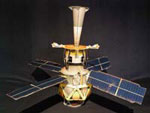Resources for Educators
On this page:
Overview of GP-B Education & Public Outreach
From curved spacetime to superconducting loops, general relativity to spinning gyroscopes, photon-detecting telescopes to superfluid helium, Gravity Probe B is replete with complex theory and incredible, cutting-edge engineering and technology. Translating these ideas into the familiar language of high school physics—let alone making them accessible to a general public audience—is no easy feat. But this has been a long-standing goal of our GP-B Education and Public Outreach (E&PO) efforts.
From 1999-June 2007, Dr. Shannon Range served as the E&PO Coordinator for Gravity Probe B. At the same time, he was enrolled as a graduate student in the Stanford School of Education, earning first an M. A. in Curriculum Studies and Teacher Education, and in June 2007, a Ph.D. in Social Sciences, Policy, and Educational Practice. Note that Range is one of many examples of how, over the years, GP-B has employed graduate students from a number of disciplines to help achieve its program objectives. See the Legacy page in the Mission Tab for more information about the broader legacy of GP-B.
As a former middle school science teacher, Range had firsthand experience with the challenges and rewards of making science and technology understandable, interesting and relevant to middle and high school students. He was thus ideally suited to developing activities and teaching aids to introduce the esoteric concepts of Einstein's general theory of relativity and the cutting-edge GP-B technologies to middle and high school audiences, as well as to the general public. Over the 8-year period that Range served as GP-B E&PO Coordinator, he traveled to 18 states (from Oregon to Florida to Massachusetts to Minnesota) and in these places, he presented the “GP-B: Testing Einstein’s Universe” story directly to over 2,000 teachers. Furthermore, here in the San Francisco Bay Area, Range visited 35 schools, presenting the GP-B story and conducting hands-on workshops in numerous classrooms, reaching dozens of teachers and thousands of students. In addition, he organized and coordinated GP-B education workshops for the public in such venues as the annual Stanford Community Day, when the University opens the campus to the general public, with booths and activities that showcase a variety of university academic and research programs.
In order to carry out these activities, Range created a set of educational materials and hands-on activities, following guidelines specified by NASA's Education and Public Outreach Office. (Every NASA mission is mandated to have an E&PO component, and GP-B is no exception.) These materials, each described in its own section below, were developed, tested and honed over the course of Range's 8-year tenure at GP-B. Along the way, he was assisted in these efforts by graphic artist and designer, Katherine Stephenson (then an undergraduate student at Stanford), Jennifer Spencer (GP-B Data Processing Lead and former Webmaster), several members of the GP-B Theory Group (a group of physicists who meet weekly to discuss and address theoretical physics issues related to GP-B and STEP), and Bob Kahn (GP-B Public Affairs Coordinator).
From 2003-2005, when the GP-B mission was in "full swing," Range used to travel the country, giving workshops at science teacher conferences and also at local schools. Range also used to mail out printed copies of our various educational materials upon request to teachers and educators, but this is no longer possible. Now that GP-B is in the final stages of data analysis and beginning preparations to conclude, we have neither staff nor budget to fulfill requests for physical copies of our educational materials. Furthermore, Range received his Ph.D. in Education in June 2007 and is now pursuing a career as an Educational Consultant. However, we have made most of these materials available in electronic formats (e.g. Adobe Acrobat PDF, Microsoft PowerPoint, etc.). Below you will find descriptions of these materials and links for downloading them from this Web site.
GP-B Educator's Guide (Grades 9-12)
This 52-page booklet provides an overview of the history, science and technology of this mission, including an introduction to Einstein's theory of curved spacetime. The guide also contains18 pages of hands-on classroom activities related to gyroscopes, curved spacetime, frame-dragging and other concepts related to the GP-B experiment. The guide contents are divided into the following seven chapters:
- Introduction to Gravity Probe B: The Relativity Mission
- From Newton's Gravity to Einstein's Curved Spacetime
- "Seeing" Spacetime with Gyroscopes
- The Gravity Probe B Science Instrument
- Concluding Question of Gravity Probe B
- Books & Articles
- Classroom Connections
Slide Presentation for Educators
This PowerPoint presentation, also available as a PDF file, contains 17 slides. It was developed for use in a classroom setting, and it can be used by teachers/educators when describing the science and technology of GP-B to a classroom or public audience. The presentation is divided into two "stories" each of which addresses a main question:
- What is Gravity Probe B, and How Does It Work?
- What is Einstein's Curved Spacetime?
Each of these stories stands alone, and the presentation order can be switched, if desired. To this end, we have created two version of the presentation: one with the "What is GP-B" question first, followed by "What is Einstein's Curved Spacetime." The second version simply reverses the presentation order, showing the Einstein story first, followed by the GP-B story. Both versions are available for downloading as Adobe Acrobat PDF files (smaller) and as Microsoft PowerPoint presentation files.
- View/download a PDF version of the GP-B/Einstein's Spacetime presentation (1.4 MB)
- Download a Microsoft PowerPoint version of the GP-B/Einstein's Spacetime presentation (11 MB)
- View download a PDF version of the Einstein's Spacetime/GP-B presentation (1.4 MB)
- Download a Microsoft PowerPoint version of the Einstein's Spacetime/GP-B presentation (11 MB)
Spacetime Triptych (3-panel) Poster
Our GP-B triptych (three-panel) poster, “Spacetime: The History, The Basics, The Tests” which was designed by Range, in collaboration with graphic artist Katherine Stephenson and GP-B Data Processing Lead/Webmaster Jennifer Spencer, was chosen as one of NASA's highlighted educational materials for the 2004-2005 school year. Each panel is 12" wide x 36" tall, and the three panels were designed to be displayed side-by-side as a single poster; thus the name "triptych." In keeping with the NASA guidelines for educational materials, the back side of each panel contains an illustrated text description of the concepts shown graphically on the front side.
| Spacetime Triptych Panels—Front Side (Click to view larger image) |
Spacetime Triptych Panels—Back Side (Click to view larger image) |
|---|---|
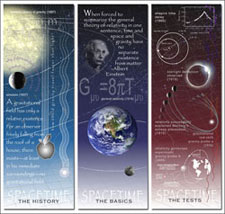 |
 |
We have created individual, full-sized (12" x 36") PDF files for each side of each panel. You can view/download any or all of these files and take them to a graphics/print shop, such as FedEx/Kinkos, to have them printed at full size. You can also print them scaled-down on smaller sized paper, if desired.
GP-B Lithograph Card Set
The GP-B Litho Card Set is a set of nine, 8"x10" cards, each with a photo or graphic image on one side and an often illustrated text description of the image on the back of the card. The litho cards, which are typical for NASA missions and were prepared to adhere to NASA E&PO guidelines, are similar to oversized postcards. They cover topics ranging from the science of GP-B, including the concepts of spacetime and frame-dragging to key GP-B technologies, such as the gyroscopes, dewar, SQUID gyro readouts and telescope.
Click on the litho thumbnails below to view/download PDF versions (front and back) of each individual card. Alternatively, you can click on the Complete 9-card Litho Set thumbnail to view/download a single PDF file containing the complete set.
| Mission Litho (2MB) | Launch Litho (1MB) | Spacecraft/Payload Litho (1MB) | Dewar Litho (3MB) |
|---|---|---|---|
 |
 |
 |
 |
| Spacetime Litho (2MB) | Frame-dragging Litho (1MB) | Gyro Litho (1MB) | Readout Litho (1MB) | Telescope Litho (2MB) |
|---|---|---|---|---|
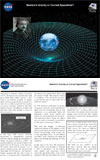 |
 |
 |
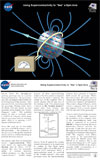 |
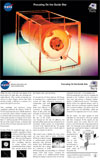 |
| Complete 9-Card Litho Set (3MB) |
|---|
 |
Paper Model of the GP-B Spacecraft
You can construct a 1/20th scale model of the GP-B spacecraft. Graphic designer, Katherine Stephenson, created the model in 2004, following the GP-B launch. Six 8.5x11" pages of model cut-out parts, plus two pages of detailed step-by-step, illustrated instructions are available in an Adobe Acrobat PDF file. Once you've printed out the pages and assembled the necessary tools (scissors, Exacto knife, glue, wooden dowels or skewers, etc.), you're ready to begin construction. It takes several hours to complete this project—and patience is a virtue—but the results are worth the effort!
Einstein's Toy
On his 76th birthday, Albert Einstein was given a toy comprised of a cup containing two small rubber balls, attached to the bottom of the cup by rubber bands. Einstein loved this toy because it provides a wonderful demonstration of the equivalence principle—the equivalence of gravity and acceleration—which is one of the key concepts underlying the general theory of relativity.
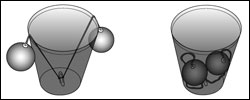
Einstein's toy cup, which demonstrates
the equivalence principle (Courtesy of
Paul Doherty, The Exploratorium)
The demonstration is quite simple to perform: You hold the cup by its rim, with the two rubber balls hanging just over the rim, supported there by the stretched rubber bands. You then drop the cup, letting it fall a foot or so and then catch it. During its fall, the cup and balls become weightless for an instant, due to the equivalence principle, and the rubber bands contract, pulling the balls inside the cup.
In the summer of 2005, an exhibit called "The Nobel Prize: 100 Years of Creativity," opened at The Exploratorium, a world-renowned, hands-on science and technology center in San Francisco, California. Senior Exploratorium Staff Scientist, Paul Doherty (a well-known physicist, teacher, author, and rock climber) created a copy of Einstein's toy as one of the hands-on activities accompanying this exhibit. Paul also created a one-page activity write up containing a description of the toy, the physics behind it, and instructions for creating the toy which was subsequently published in the Summer 2005 issue of the Exploratorium Magazine and added as an online activity in the Exploratorium's Nobel Prize exhibit Web pages.





